ListDensityPlot[{{f11,…,f1n},…,{fm1,…,fmn}}]
generates a smooth density plot from an array of values fij.
ListDensityPlot[{{x1,y1,f1},…,{xk,yk,fk}}]
generates a density plot with values fi defined at specified points {xi,yi}.




ListDensityPlot
ListDensityPlot[{{f11,…,f1n},…,{fm1,…,fmn}}]
generates a smooth density plot from an array of values fij.
ListDensityPlot[{{x1,y1,f1},…,{xk,yk,fk}}]
generates a density plot with values fi defined at specified points {xi,yi}.
Details and Options



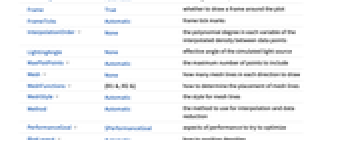
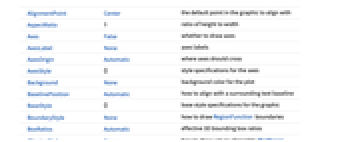
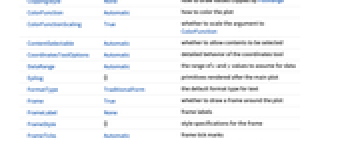
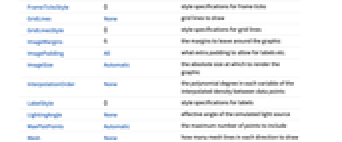

- ListDensityPlot is also known as heat map and intensity plot.
- Regular data {{f11,…,f1n},…,{fm1,…,fmn}} is plotted as a color
 at the point {x,y} where
at the point {x,y} where  has value fij and c is a color-valued function.
has value fij and c is a color-valued function. - Irregular data {{x1,y1,f1},…,{xk,yk,fk}} is plotted as a color
 at the point {x,y} where
at the point {x,y} where  has value fi and c is a color-valued function.
has value fi and c is a color-valued function. - The plot visualizes the set
 where
where  is a color-valued function and the region
is a color-valued function and the region  is the Cartesian product
is the Cartesian product  for regular data and the convex hull of {{x1,y1},…,{xn,yn}} for irregular data.
for regular data and the convex hull of {{x1,y1},…,{xn,yn}} for irregular data. - For regular data {{f11,…,f1n},…,{fm1,…,fmn}}, the
 location for value fij is taken to be
location for value fij is taken to be  . Use the option DataRange to override that.
. Use the option DataRange to override that. - ListDensityPlot is intended for continuous data; ArrayPlot is intended for discrete data.
- By default, the color scale generates output in which larger values are shown as lighter colors.
- ListDensityPlot[data] can use the following forms and interpretations for data:
-
{<|xkeyx1,ykeyy1,fkeyf1|>,…,<|xkeyxn,ykeyyn,fkeyfn|>} irregular  triples {xi,yi,fi}
triples {xi,yi,fi}{{x1,y1},…,{xn,yn}}{f1,…,fn} irregular  triples {xi,yi,fi}
triples {xi,yi,fi}Dataset values as a normal array NumericArray values as a normal array QuantityArray magnitudes SparseArray values as a normal array - ListDensityPlot[Tabular[…]cspec] extracts and plots values from the tabular object using the column specification cspec.
- The following forms of column specifications cspec are allowed for plotting tabular data:
-
{colx,coly,colz} plot column z against columns x and y {{colx1,coly1,colz1},{colx2,coly2,colz2},…} plot column z1 against column x1 and y1 , z2 against x2 and y2, etc. - ListDensityPlot has the same options as Graphics, with the following additions and changes: [List of all options]
-
AspectRatio 1 ratio of height to width BoundaryStyle None how to draw RegionFunction boundaries BoxRatios Automatic effective 3D bounding box ratios ClippingStyle None how to draw values clipped by PlotRange ColorFunction Automatic how to color the plot ColorFunctionScaling True whether to scale the argument to ColorFunction DataRange Automatic the range of x and y values to assume for data Frame True whether to draw a frame around the plot FrameTicks Automatic frame tick marks InterpolationOrder None the polynomial degree in each variable of the interpolated density between data points LightingAngle None effective angle of the simulated light source MaxPlotPoints Automatic the maximum number of points to include Mesh None how many mesh lines in each direction to draw MeshFunctions {#1&,#2&} how to determine the placement of mesh lines MeshStyle Automatic the style for mesh lines Method Automatic the method to use for interpolation and data reduction PerformanceGoal $PerformanceGoal aspects of performance to try to optimize PlotFit None how to fit a curve to the points PlotFitElements Automatic fitted elements to show in the plot PlotLayout Automatic how to position densities PlotLegends None legends for color gradients PlotRange {Full,Full,Automatic} the range of f or other values to include PlotRangePadding Automatic how much to pad the range of values PlotRangeClipping True whether to clip at the plot range PlotTheme $PlotTheme overall theme for the plot RegionFunction (True&) how to determine whether a point should be included ScalingFunctions None how to scale individual coordinates VertexColors Automatic colors to assume at every point - DataRange determines the {x,y} position for value fij in the array {{f11,…,f1n},…,{fm1,…,fmn}}. Possible settings include:
-
Automatic,All uniform in x from 1 to n and in y from 1 to m {{xmin,xmax},{ymin,ymax}} uniform in x from xmin to xmax and in y from ymin to ymax - The case ListDensityPlot[{{a11,a12,a13},…}] can be interpreted as both regular and irregular data. With DataRange->Automatic it is interpreted as irregular {{x1,y1,f1},{x2,y2,f2},…} and with DataRangeAll it is interpreted as regular {{f11,…,f1n},…,{fm1,…,fmn}}.
- Possible settings for ScalingFunctions include:
-
sf scale the f-values {sx,sy} scale x and y axes {sx,sy,sf} scale x and y axes and f-values - Each scaling function si is either a string "scale" or {g,g-1}, where g-1 is the inverse of g.
- For ListDensityPlot[array], Mesh->Full draws a mesh that crosses at the position of each data point.
- The arguments supplied to functions in MeshFunctions and RegionFunction are x, y, f.
- ColorFunction is supplied with a single argument, given by default by the scaled value of f.
- Typical settings for PlotLegends include:
-
None no legend Automatic automatically determine legend from ColorFunction Placed[lspec,…] specify placement for legend - Possible settings for PlotLayout that show single densities in multiple plot panels include:
-
"Column" use separate densities in a column of panels "Row" use separate densities in a row of panels {"Column",k},{"Row",k} use k columns or rows {"Column",UpTo[k]},{"Row",UpTo[k]} use at most k columns or rows - The setting for VertexColors must be an array or list with the same structure as the array or list of values.
- An explicit setting for VertexColors overrides colors determined from ColorFunction.
- ListDensityPlot returns Graphics[GraphicsComplex[data]].
-
 Highlight options with settings specific to ListDensityPlot
Highlight options with settings specific to ListDensityPlot
-
AlignmentPoint Center the default point in the graphic to align with AspectRatio 1 ratio of height to width Axes False whether to draw axes AxesLabel None axes labels AxesOrigin Automatic where axes should cross AxesStyle {} style specifications for the axes Background None background color for the plot BaselinePosition Automatic how to align with a surrounding text baseline BaseStyle {} base style specifications for the graphic BoundaryStyle None how to draw RegionFunction boundaries BoxRatios Automatic effective 3D bounding box ratios ClippingStyle None how to draw values clipped by PlotRange ColorFunction Automatic how to color the plot ColorFunctionScaling True whether to scale the argument to ColorFunction ContentSelectable Automatic whether to allow contents to be selected CoordinatesToolOptions Automatic detailed behavior of the coordinates tool DataRange Automatic the range of x and y values to assume for data Epilog {} primitives rendered after the main plot FormatType TraditionalForm the default format type for text Frame True whether to draw a frame around the plot FrameLabel None frame labels FrameStyle {} style specifications for the frame FrameTicks Automatic frame tick marks FrameTicksStyle {} style specifications for frame ticks GridLines None grid lines to draw GridLinesStyle {} style specifications for grid lines ImageMargins 0. the margins to leave around the graphic ImagePadding All what extra padding to allow for labels etc. ImageSize Automatic the absolute size at which to render the graphic InterpolationOrder None the polynomial degree in each variable of the interpolated density between data points LabelStyle {} style specifications for labels LightingAngle None effective angle of the simulated light source MaxPlotPoints Automatic the maximum number of points to include Mesh None how many mesh lines in each direction to draw MeshFunctions {#1&,#2&} how to determine the placement of mesh lines MeshStyle Automatic the style for mesh lines Method Automatic the method to use for interpolation and data reduction PerformanceGoal $PerformanceGoal aspects of performance to try to optimize PlotFit None how to fit a curve to the points PlotFitElements Automatic fitted elements to show in the plot PlotLabel None an overall label for the plot PlotLayout Automatic how to position densities PlotLegends None legends for color gradients PlotRange {Full,Full,Automatic} the range of f or other values to include PlotRangeClipping True whether to clip at the plot range PlotRangePadding Automatic how much to pad the range of values PlotRegion Automatic the final display region to be filled PlotTheme $PlotTheme overall theme for the plot PreserveImageOptions Automatic whether to preserve image options when displaying new versions of the same graphic Prolog {} primitives rendered before the main plot RegionFunction (True&) how to determine whether a point should be included RotateLabel True whether to rotate y labels on the frame ScalingFunctions None how to scale individual coordinates Ticks Automatic axes ticks TicksStyle {} style specifications for axes ticks VertexColors Automatic colors to assume at every point
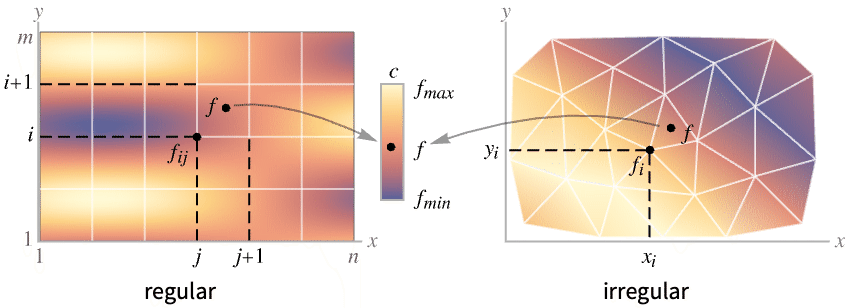

List of all options
Examples
open all close allBasic Examples (4)
Scope (16)
Data (8)
For regular data consisting of ![]() values, the
values, the ![]() and
and ![]() data ranges are taken to be integer values:
data ranges are taken to be integer values:
Provide explicit ![]() and
and ![]() data ranges by using DataRange:
data ranges by using DataRange:
For irregular data consisting of ![]() triples, the
triples, the ![]() and
and ![]() data ranges are inferred from data:
data ranges are inferred from data:
Areas around where the data is nonreal are excluded:
Use MaxPlotPoints to limit the number of points used:
PlotRange is selected automatically:
Use PlotRange to focus in on areas of interest:
Use RegionFunction to restrict the density to a region given by inequalities:
Tabular Data (1)
Presentation (7)
Provide an interactive Tooltip for the density:
Use a theme with simple ticks and a legend in a bold color scheme:
Use a multipanel layout to show multiple datasets at the same time:
Options (98)
AspectRatio (4)
By default, ListDensityPlot uses the same width and height:
Use a numerical value to specify the height to width ratio:
AspectRatioAutomatic determines the ratio from the plot ranges:
AspectRatioFull adjusts the height and width to tightly fit inside other constructs:
Axes (4)
By default, ListDensityPlot uses a frame instead of axes:
Use AxesOrigin to specify where the axes intersect:
AxesLabel (4)
AxesOrigin (2)
AxesStyle (4)
BoundaryStyle (4)
No boundary is used by default:
Use a red boundary around the edges of the surface:
BoundaryStyle applies to holes cut by RegionFunction:
BoundaryStyle applies between Voronoi regions associated with the data:
ClippingStyle (4)
ColorFunction (5)
ColorFunctionScaling (1)
Get the natural range of values by setting ColorFunctionScaling to False:
DataRange (4)
ImageSize (7)
Use named sizes such as Tiny, Small, Medium and Large:
Specify the width of the plot:
Specify the height of the plot:
Allow the width and height to be up to a certain size:
Specify the width and height for a graphic, padding with space if necessary:
Setting AspectRatioFull will fill the available space:
Use maximum sizes for the width and height:
Use ImageSizeFull to fill the available space in an object:
Specify the image size as a fraction of the available space:
InterpolationOrder (5)
MaxPlotPoints (4)
ListDensityPlot normally uses all the points in the dataset:
Limit the number of points used in each direction:
MaxPlotPoints imposes a regular grid on irregular data:
The grid does not extend beyond the convex hull of the original data:
Mesh (7)
MeshFunctions (3)
MeshStyle (3)
PerformanceGoal (2)
PlotFit (4)
By default, density gradients can be very detailed:
Fitting the data results in smoother plots:
Fit a quadratic surface to the data:
Use KernelModelFit to approximate the data:
PlotLayout (3)
PlotLegends (5)
PlotRange (2)
PlotTheme (2)
RegionFunction (4)
The region depends on DataRange:
ScalingFunctions (9)
By default, plots have linear scales in each direction:
Use a log scale in the ![]() direction:
direction:
Use a linear scale in the ![]() direction that shows smaller numbers at the top:
direction that shows smaller numbers at the top:
Use a reciprocal scale in the ![]() direction:
direction:
Use different scales in the ![]() and
and ![]() directions:
directions:
Reverse the ![]() axis without changing the
axis without changing the ![]() axis:
axis:
Use a scale defined by a function and its inverse:
Positions in Ticks and GridLines are automatically scaled:
PlotRange is automatically scaled:
VertexColors (2)
ListDensityPlot usually colors the density using a color function:
Applications (3)
Plot a probability density function of two variables:
Compare to the empirical density function:
Show the regions closest to a set of points:
Show ozone density around the world:
Use CountryData to add country outlines:
Properties & Relations (16)
ListDensityPlot is similar to ListPlot3D viewed from above:
ListDensityPlot and ListPlot3D view ![]() as a function of
as a function of ![]() and
and ![]() :
:
The data has only one ![]() value for each
value for each ![]() ,
, ![]() pair:
pair:
The data has two ![]() values for each
values for each ![]() ,
, ![]() pair:
pair:
Use ListDensityPlot3D to plot 3D data:
ListDensityPlot associates colors with the vertices of polygons:
Raster, ArrayPlot, MatrixPlot, and ReliefPlot associate colors with the whole polygon:
Use ArrayPlot for arrays of discrete data:
Use MatrixPlot for structural plots of matrices:
Use ReliefPlot for matrices corresponding to medical and geographic values:
Use DensityPlot for functions:
Smoothly shade a map using color with GeoDensityPlot:
Use ListPointPlot3D to show three-dimensional points:
ListDensityPlot produces smooth color variations:
Use ListContourPlot to get segmented colors:
Use ListPlot3D to create surfaces from continuous data:
Use ListLogPlot, ListLogLogPlot, and ListLogLinearPlot for logarithmic plots:
Use ListPolarPlot for polar plots:
Use DateListPlot to show data over time:
Use ParametricPlot3D for three-dimensional parametric curves and surfaces:
Possible Issues (2)
Neat Examples (1)
Tech Notes
History
Introduced in 1988 (1.0) | Updated in 2007 (6.0) ▪ 2008 (7.0) ▪ 2012 (9.0) ▪ 2014 (10.0) ▪ 2016 (11.0) ▪ 2017 (11.1) ▪ 2021 (13.0) ▪ 2025 (14.2) ▪ 2025 (14.3)
Text
Wolfram Research (1988), ListDensityPlot, Wolfram Language function, https://reference.wolfram.com/language/ref/ListDensityPlot.html (updated 2025).
CMS
Wolfram Language. 1988. "ListDensityPlot." Wolfram Language & System Documentation Center. Wolfram Research. Last Modified 2025. https://reference.wolfram.com/language/ref/ListDensityPlot.html.
APA
Wolfram Language. (1988). ListDensityPlot. Wolfram Language & System Documentation Center. Retrieved from https://reference.wolfram.com/language/ref/ListDensityPlot.html
BibTeX
@misc{reference.wolfram_2025_listdensityplot, author="Wolfram Research", title="{ListDensityPlot}", year="2025", howpublished="\url{https://reference.wolfram.com/language/ref/ListDensityPlot.html}", note=[Accessed: 03-January-2026]}
BibLaTeX
@online{reference.wolfram_2025_listdensityplot, organization={Wolfram Research}, title={ListDensityPlot}, year={2025}, url={https://reference.wolfram.com/language/ref/ListDensityPlot.html}, note=[Accessed: 03-January-2026]}